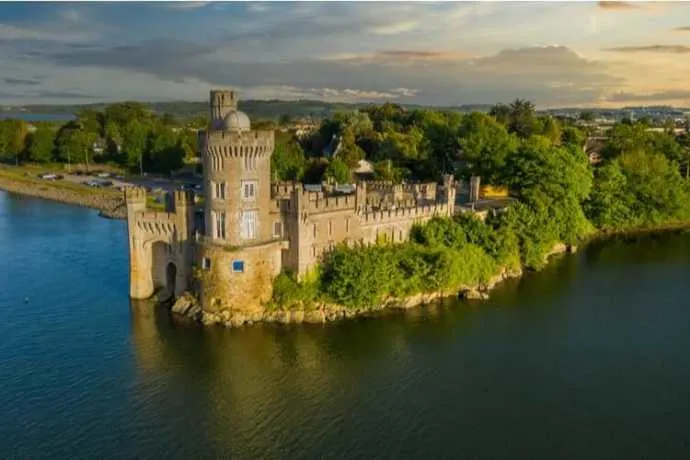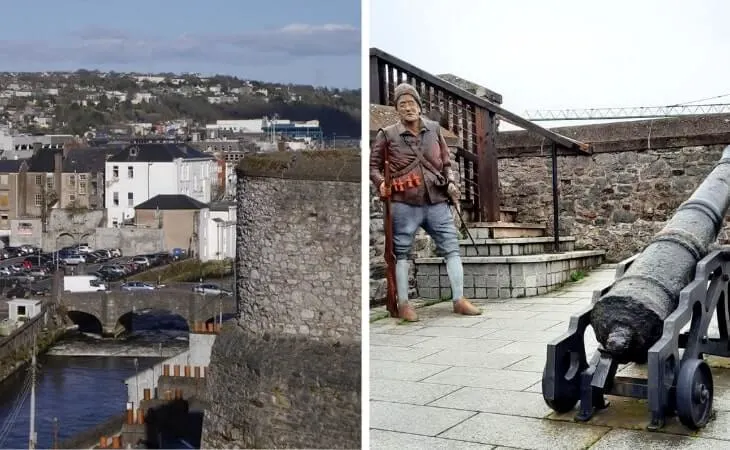A visit to the Elizabeth Fort is up there with my favourite things to do in Cork.
If you’re a fan of Irish history and you’d like to step back in time for an hour or so, a visit to the mighty Elisabeth Fort is well worth doing.
Named for Queen Elizabeth I and built in 1601, the fort offers the visitor the chance to find out more about Cork’s turbulent past and makes a great day out for all the family.
In the guide below, you’ll find info on everything from the history of Elisabeth Fort to what there is to do inside.
Some quick need-to-knows about Elizabeth Fort

Photo via Elizabeth Fort
Although a visit to Elizabeth Fort in Cork City is fairly straightforward, there are a few need-to-knows that’ll make your visit that bit more enjoyable.
1. Location
You’ll find Elizabeth Fort just off Barrack Street in Cork. Now, if you’re thinking, ‘Wait – I thought it was in Kinsale‘, then you’re mixing it up with Charles Fort – it’s an easy mistake to make!
2. Opening hours
From October to April, the fort is open Tuesdays to Saturdays 10am until 5pm, and on Sundays from 12pm to 5pm. In the months May to September, the fort opens Monday to Saturday 10am to 5pm, and Sundays 12pm until 5pm (times may change).
3. Admission/prices
General admission to the fort is free of charge, but there is a guided tour that takes place every day the fort is open at 1pm. The charge for this is €5 per person, though under 12-year-ols can do the tour for free (prices may change).
A history of Elizabeth Fort
The history of Elizabeth Fort in Cork spans centuries, and I won’t do the many events that took place here justice with a couple of paragraphs.
The below history of Elizabeth Fort is intended to give you a taste of the story behind the fort – you’ll discover the rest when you walk through its doors.
Early days
Elizabeth Fort was first built in 1601 on a hill to the south and outside the old Medieval walls of the city.
Its position was chosen because the people of Cork has previously relied on the Shandon Castle and the city walls for their defence, but as artillery developed in the Middle Ages this became untenable.
It was built by Sir George Carew and constructed from timber and earth. Cork’s population pulled the fort down in 1603, worried that it might be used against them by the English Crown. Lord Mountjoy retook the fortification soon afterwards and ordered its rebuilding.
The siege of Cork
The siege took place in 1690 during the Williamite wars in Ireland, when King James II attempted to retake the English crown from his son-in-law, William III.
James had been overthrown in 1688, but had retained many loyal supporters in Ireland. John Churchill, the 1st Duke of Marlborough on behalf of King William, reached Cork in the September of that year and took Elizabeth Fort among other places.
When the city surrendered, Williamite forces sacked the city, causing wide-spread damage and killing civilians.
The later years
in the early 19th century, the fort was used as a holding place for prisoners awaiting transportation on the convict ships heading for Australia.
When the Great Famine struck in the 1840s, the fort was used as a food depot – one of ten in the city that fed up to 20,000 people every day.
During the Irish War of Independence, the fort was used by the British army fighting against the Irish Republican Army.
In the Irish Civil war, anti-treaty forces held the fort and buildings within it were burnt down when the anti-treaty forces left. The new Garda station was built within the fort in 1929 and was used as such until 2013.
The Elizabeth Fort Tour

Photos via Shutterstock
The Elizabeth Fort tour has racked up rave reviews online, and it’s well worth doing (you’ll have seen us rave about it in our guide to the best things to do in Cork City).
The tour costs €3 per person and takes place every day at 1pm (prices and times may change) Informative staff will guide you around the fort and explain its different uses over the years, as well as touching on the history of Cork City.
You’ll be offered an insight into the role the fort played in the Jacobite wars, the English and Irish civil wars and more. You will also experience great views of the city.
Things to do near Elizabeth Fort
One of the beauties of Elizabeth Fort is that it’s a short spin away from a clatter of other attractions. There’s plenty of beaches near Cork City and there are lots of walks in Cork to head off on.
Below, you’ll find a handful of things to see and do a stone’s throw from Elizabeth Fort (plus places to eat and where to grab a post-adventure pint!).
1. The English Market

Photos via the English Market on Facebook
You might wonder what makes the English Market English, given its location, but the market is so-called because it originated in the late 18th century when Ireland was part of the British empire.
In the 19th century, the market was a crucial part of Cork’s economy; local traders from far and wide gathering there to sell their stocks. Today, you will find a rich and diverse range of food and drink – butchers, fishmongers, delis and bakers.
2. Blackrock Castle

Photo by mikemike10 (shutterstock)
Blackrock Castle Observatory now serves as a professional observatory and a museum that promotes science and technology through astronomy.
The Journey of Exploration permanent exhibition traces the castle’s origins in the late 16th century through its military, civic and private uses to the present-day observatory. The present-day castle café is known for its fresh, local and delicious food.
3. The Butter Museum

Photo via the Butter Museum
The Butter Museum has been an important foodstuff for people in Ireland for hundreds if not thousands of years, as the exhibits within the Butter Museum demonstrate. Here, you will find a fascinating documentation of the part butter played (and plays) in Ireland’s economy.
4. Saint Fin Barre’s Cathedral

Photo by ariadna de raadt (Shutterstock)
The patron saint of Cork, Fin Barre’s Cathedral is a dramatic building of architectural brilliance. Built in the 19th century, the cathedral celebrated its 150th birthday in 2020.
William Burges, its architect and builder, repurposed competition entries he had submitted unsuccessfully to other invites for cathedral/building design. Their loss was Cork’s gain!
5. Pubs and restaurants

Photo left via Coughlan’s. Photo right via the Crane Lane on Facebook
There are heaps of great pubs in Cork and there are even more incredible restaurants in Cork where you can whittle away an evening.
If you’re looking for an early bite to eat, drop into our guides to the best breakfast in Cork and the best brunch in Cork.
6. Cork Gaol

Photos via Shutterstock
19th century justice was harsh, imprisoning people too often for crimes of poverty, such as stealing a loaf of bread. Explore this part of Cork’s history at Cork City Gaol, which was used for the imprisonment of the area’s female ‘wrong-doers’ in the latter 19th century and then as a radio broadcasting building.
FAQs about Elizabeth Fort
We’ve had a lot of questions over the years asking about everything from whether Elizabeth Fort in Cork is worth visiting to what to see nearby.
In the section below, we’ve popped in the most FAQs that we’ve received. If you have a question that we haven’t tackled, ask away in the comments section below.
What is there to do at Elizabeth Fort?
Although the tour is what attracts many to Elizabeth Fort in Cork, it’s the views from the top that pack a punch! Come for the history, stay for the incredible Cork City views.
Is Elizabeth Fort worth visiting?
Yes – Elizabeth Fort is well worth a visit during your trip to Cork. It’s packed with history and you won’t need a huge amount of time to get around it.
What is there to do near Elizabeth Fort?
There’s lots to see and do near Elizabeth Fort, from an endless number of places to eat (and drink, if you like!) ancient sites, like the Castle and the Cathedral to gorgeous river walks.

